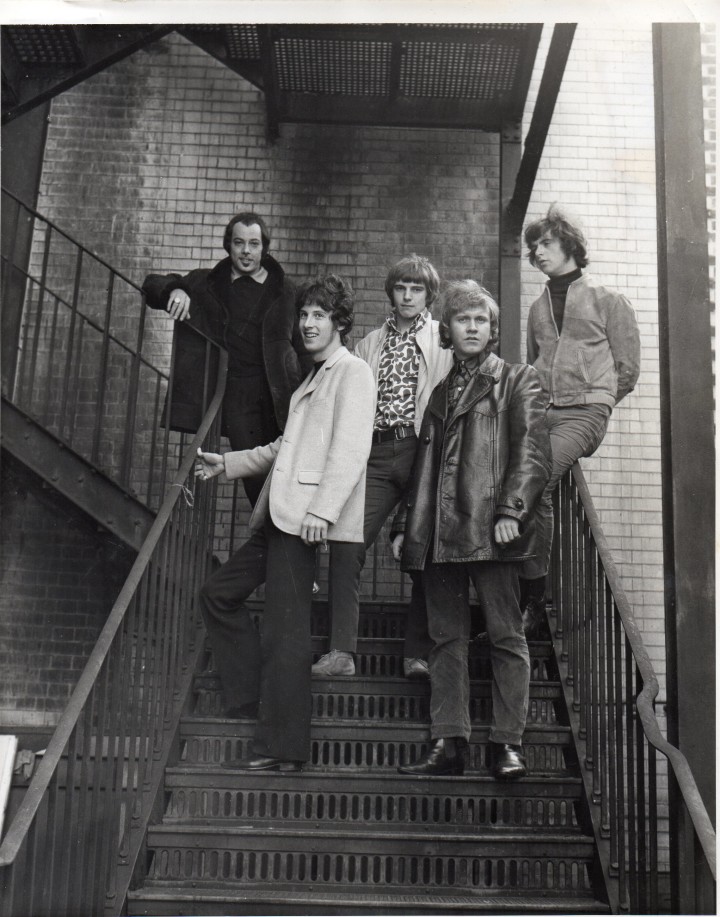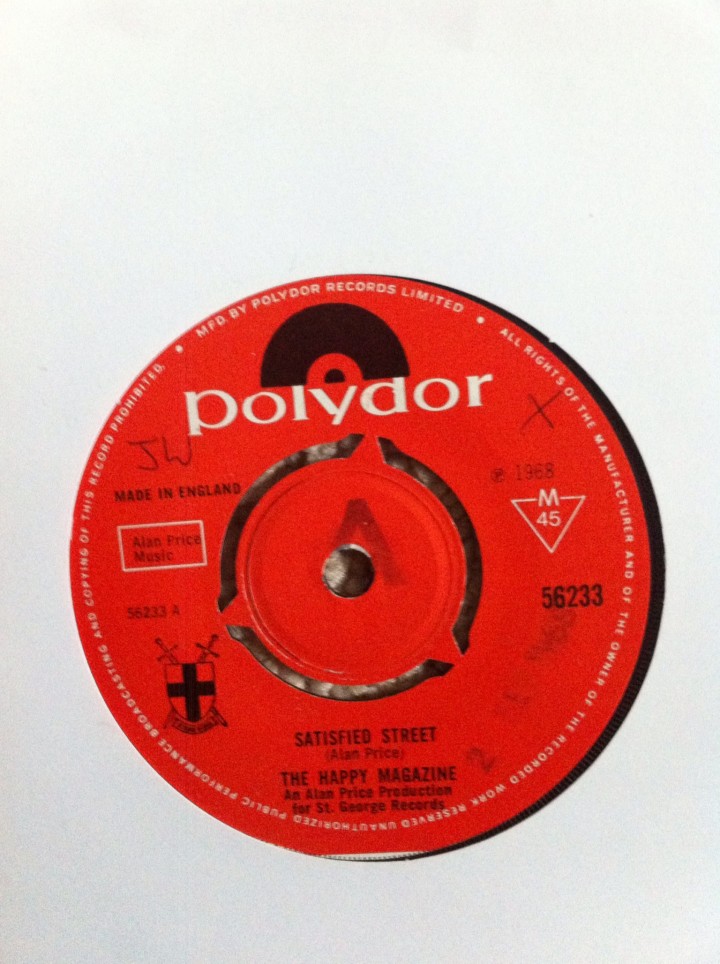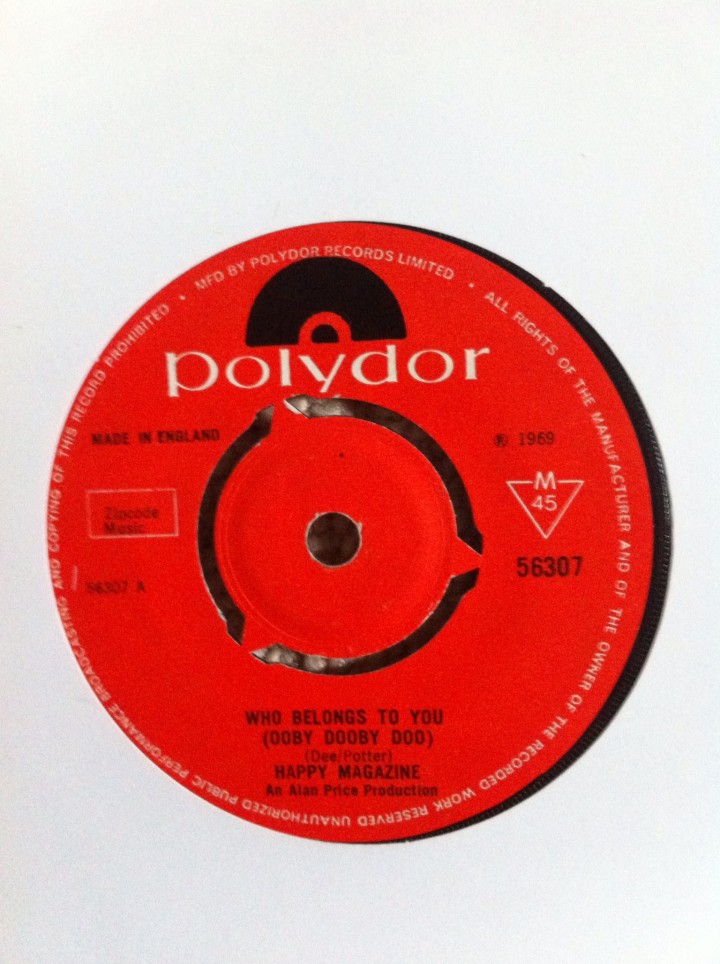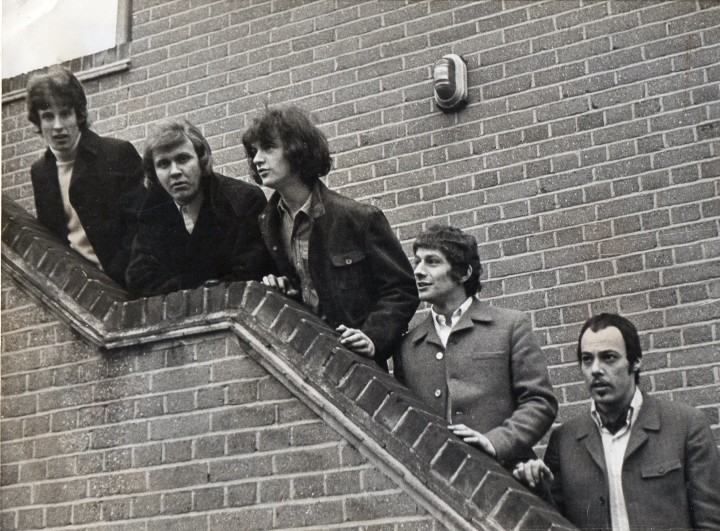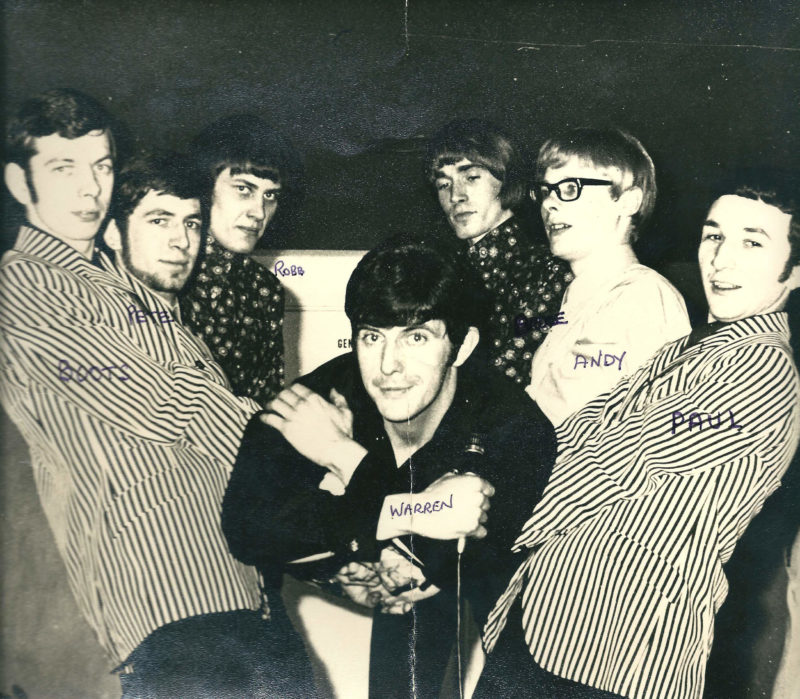
Formed from the ashes of Croydon R&B outfit, The Boardwalkers, who’d recorded two tracks on a private pressing demo single – “A Miracle” and “Any Man’s Girl” (two versions), the original Warren Davis Monday Band came together in January 1967.
Warren Davis – (aka Max Spinks) – lead vocals
Rob Walker – lead guitar/vocals
Andy Wilson – Hammond organ
Bruce Usherwood – bass/vocals
Paul Houlton – tenor saxophone
Martin Grice – tenor saxophone
Peter Mole – drums
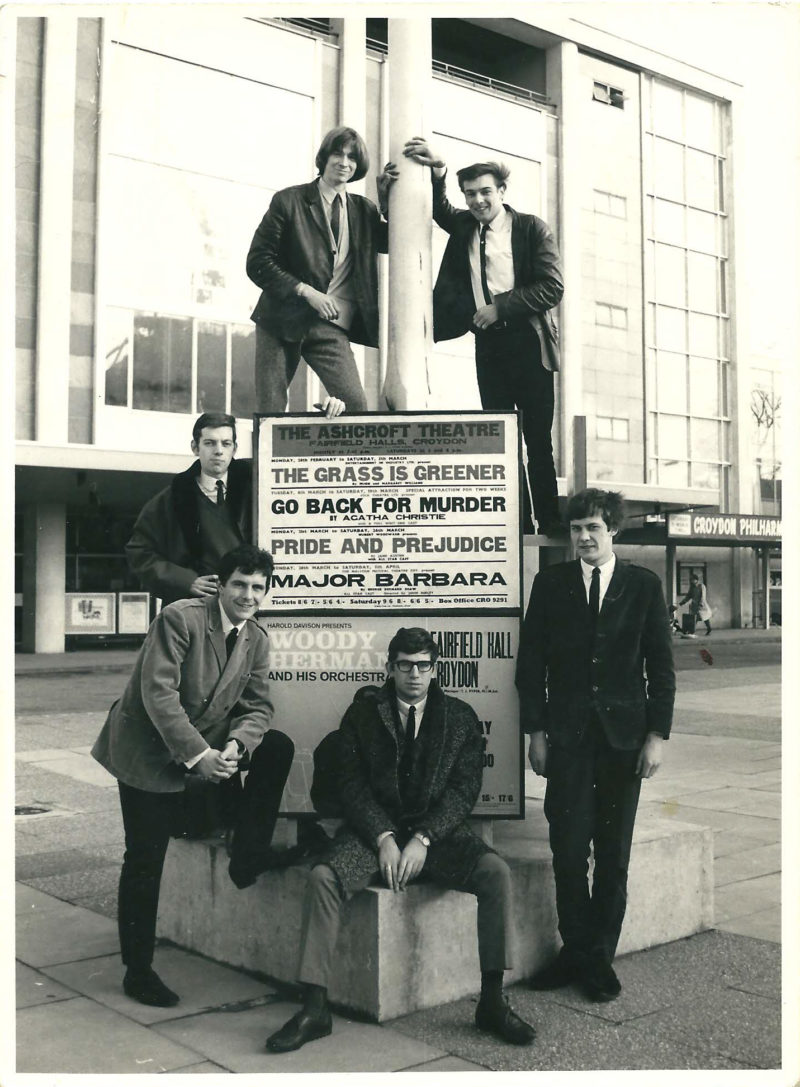
This formation cuts the band’s debut single – Bill Wyman and Peter Gosling’s “Wait For Me” c/w Warren Davis’ “I Don’t Wanna Hurt You” (Columbia BD 8190). Usherwood knew Wyman and Gosling, who was working with Moon’s Train.

7 January 1967 – Southwark Pop Scene, Newington Public Hall, Walworth Road, south London with Manfred Mann and Dave Cash (South East London Mercury)
20 January 1967 – Beachcomber, Nottingham (Nottingham Evening Post)
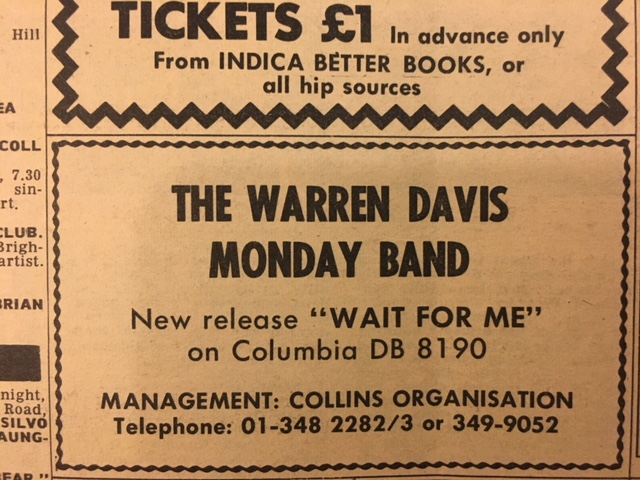
22 January 1967 – Whisky A Go Go, Wardour Street, Soho, central London
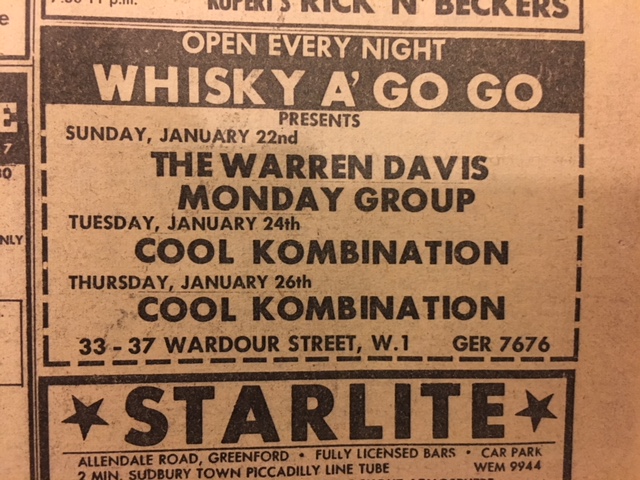
29 January 1967 – Whisky A Go Go, Wardour Street, Soho, central London

4 February 1967 – Carlton Club, Erdington, West Midlands with The Bobcats
5 February 1967 – Whisky A Go Go, Wardour Street, Soho, central London
10 February 1967 – Upper Cut, Forest Gate, east London with The Rockin’ Berries

11 February 1967 – Manhole, Redhill, Surrey
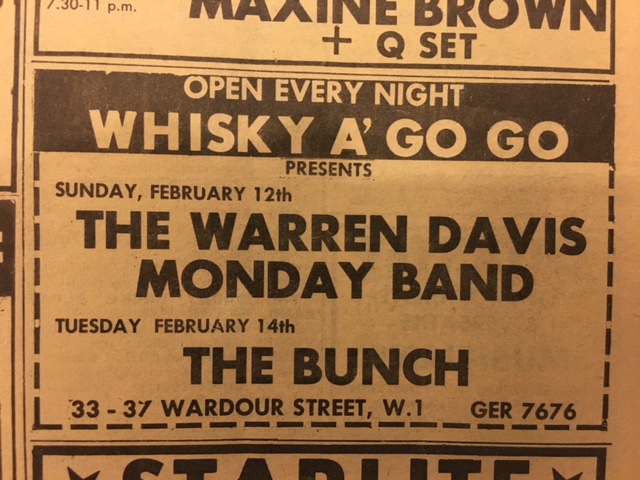
12 February 1967 – Whisky A Go Go, Wardour Street, central Soho, London

18 February 1967 – 2 ‘B’s Club, Ashford, Kent with support (Kentish Express)
23 February 1967 – New Central Ballroom, Aldershot, Hampshire with Ty-Burns (Aldershot News)
25 February 1967 – New Central Ballroom, Aldershot, Hampshire with The Shame (Aldershot News)
5 March 1967 – Whisky A Go Go, Wardour Street, Soho, central London
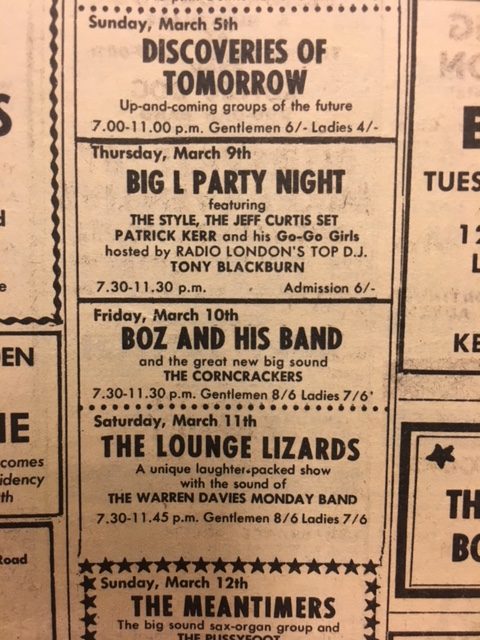
11 March 1967 – Upper Cut, Forest Gate, east London
12 March 1967 – Whisky A Go Go, Wardour Street, Soho, central London
19 March 1967 – Whisky A Go Go, Wardour Street, Soho, central London
26 March 1967 – Whisky A Go Go, Wardour Street, Soho, central London
1 April 1967 – Upper Cut, Forest Gate, east London with Dave Berries & The Cruisers
2 April 1967 – Upper Cut, Forest Gate, east London
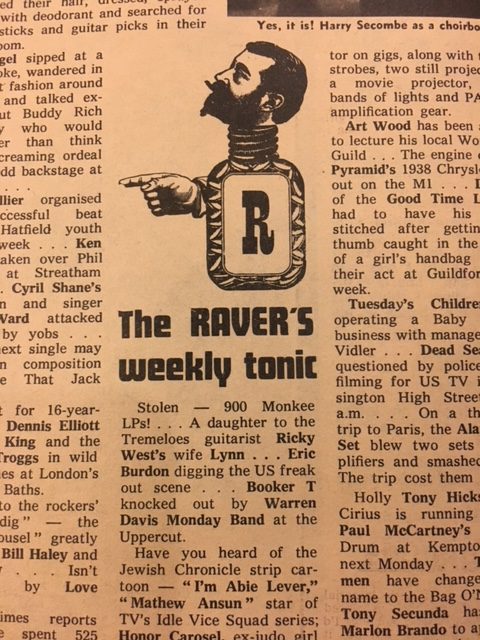
8 April 1967 – Booker T & The MGs rave about them in Melody Maker
9 April 1967 – Upper Cut, Forest Gate, east London
15 April 1967 – Upper Cut, Forest Gate, east London
16 April 1967 – Upper Cut, Forest Gate, east London
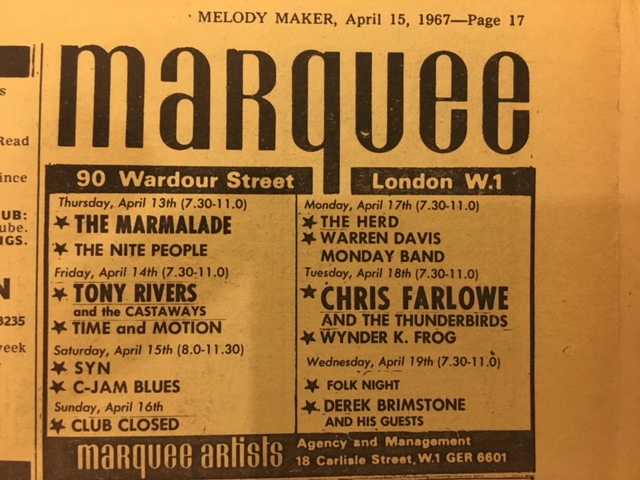
17 April 1967 – Marquee, Wardour Street, Soho, central London with The Herd
22-23 April 1967 – Upper Cut, Forest Gate, east London (Newham, West Ham & East Ham, Barking and Stratford Express)
27 April 1967 – Whisky A Go Go, Wardour Street, Soho, central London
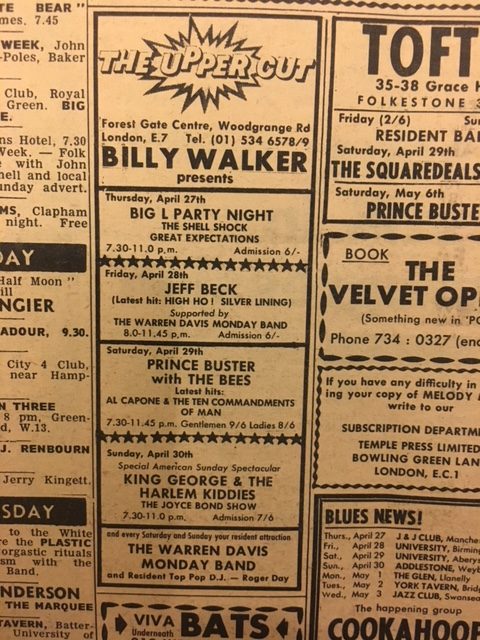
28 April 1967 – Upper Cut, Forest Gate, east London with Jeff Beck Group
29-30 April 1967 – Upper Cut, Forest Gate, east London
4 May 1967 – Whisky A Go Go, Wardour Street, Soho, central London
6-7 May 1967 – Upper Cut, Forest Gate, east London
13 May 1967 – Upper Cut, Forest Gate, east London with Terry Reid with Peter Jay & The Jaywalkers
Around this time, the band was joined briefly by Welshman, guitarist Dave Edmunds, who took over from Rob Walker. Melody Maker‘s 13 May issue, page 14, includes an advert for the group looking for a new singer and guitarist.
Edmunds who would soon move on to join the band that became Love Sculpture later became a successful solo artist. Walker briefly returned to the group after Edmunds had played only a handful of gigs.
14 May 1967 – Upper Cut, Forest Gate, east London
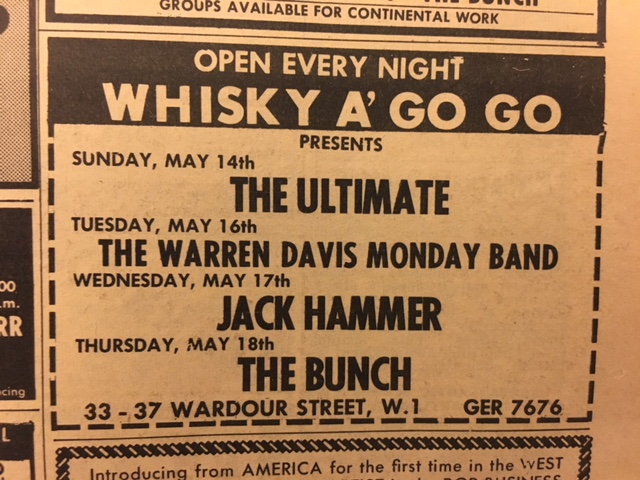
16 May 1967 – Whisky A Go Go, Wardour Street, Soho, central London
21 May 1967 – Upper Cut, Forest Gate, east London
25 May 1967 – Whisky A Go Go, Wardour Street, Soho, central London
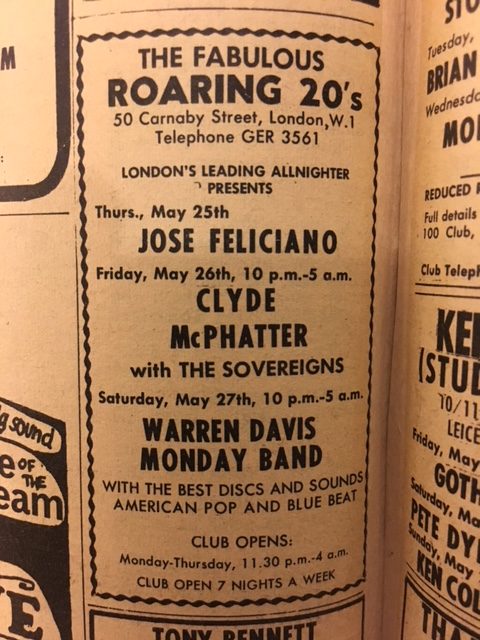
27 May 1967 – Roaring 20s, Carnaby Street, Soho, central London
28 May 1967 – Upper Cut, Forest Gate, east London with Sookie Dolls
4 June 1967 – Upper Cut, Forest Gate, east London

5 June 1967 – Club Cedar, Birmingham with Edwin Starr and Band of Joy

6 June 1967 – Dungeon, Nottingham with Edwin Starr
8 June 1967 – Whisky A Go Go, Wardour Street, Soho, central London (Edwin Starr gig but most likely The Warren Davis Monday Band as backing group)

9 June 1967 – Britannia Rowing Club, Nottingham with Edwin Starr
9 June 1967 – Beachcomber Club, Nottingham with Edwin Starr

10 June 1967 – Starlight Ballroom, Boston Gliderdrome, Boston, Lincolnshire with Manfred Mann, Edwin Starr, The Darlings and Ray Bones
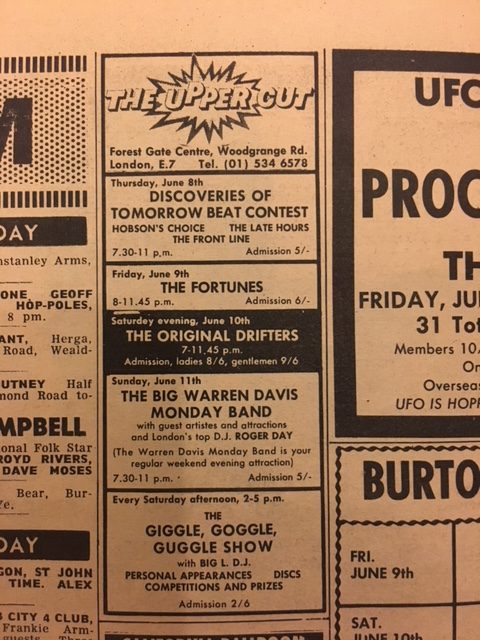
11 June 1967 – Upper Cut, Forest Gate, east London
12 June 1967 – Atlanta Ballroom, Woking, Surrey with Edwin Starr
18 June 1967 – Upper Cut, Forest Gate, east London
25 June 1967 – Upper Cut, Forest Gate, east London
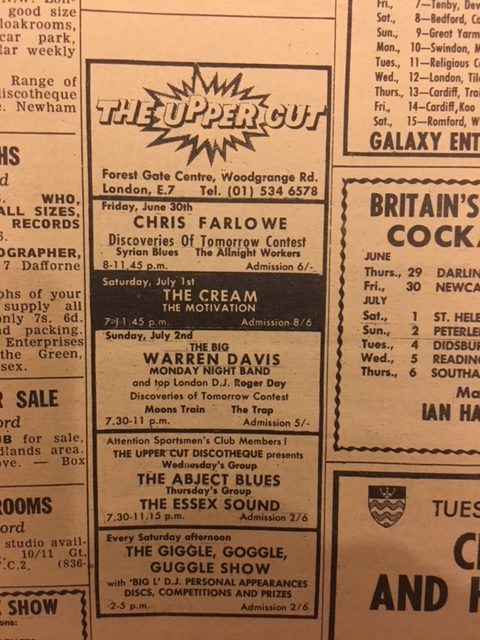
2 July 1967 – Upper Cut, Forest Gate, east London with Moons Train and The Trap
8 July 1967 – Upper Cut, Forest Gate, east London with The Small Faces
9 July 1967 – Upper Cut, Forest Gate, east London
Rob Walker left permanently around now. Further changes took place soon after when Andy Wilson and Paul Houlton also departed, the latter to join Moon’s Train.
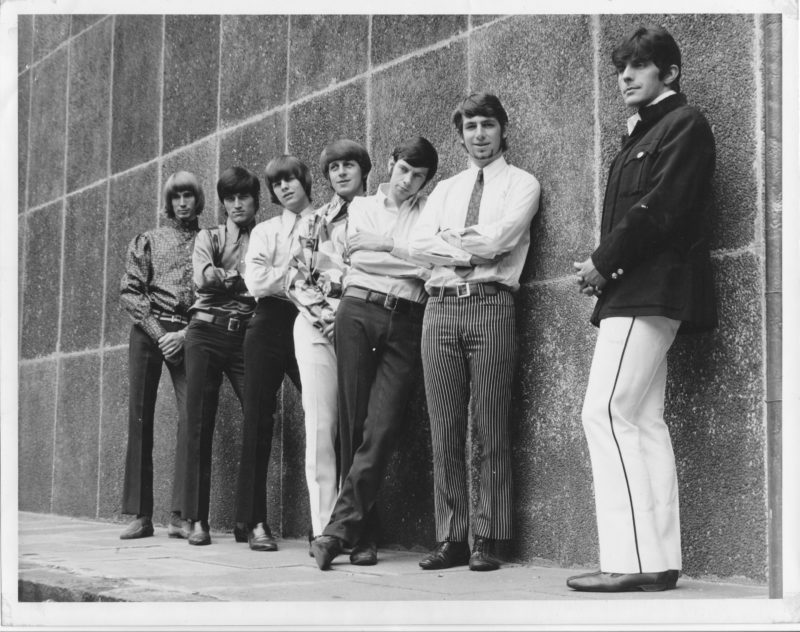
A new line-up comprised:
Warren Davis – lead vocals
David Foster – keyboards (came over from Vancouver with The Canadian Strangers)
Mick Patel – lead guitar/saxophone/vocals (ex-Loose Ends)
Martin Grice – tenor saxophone
Bruce Usherwood – bass/vocals
Peter Mole – drums
While the band was rehearsing at Billy Walker’s Upper Cut, they auditioned tenor saxophone Derek “Del” Paramor, who joined from Vince Edwards’ group. Until May 1967, he’d worked with David Essex & The Mood Indigo.
15 July 1967 – Upper Cut, Forest Gate, east London with Wynder K Frog (new line up’s debut)
16 July 1967 – Upper Cut, Forest Gate, east London

22 July 1967 – Central R&B Club, Gillingham, Kent with Derrick Dee Soul Show
23 July 1967 – Upper Cut, Forest Gate, east London
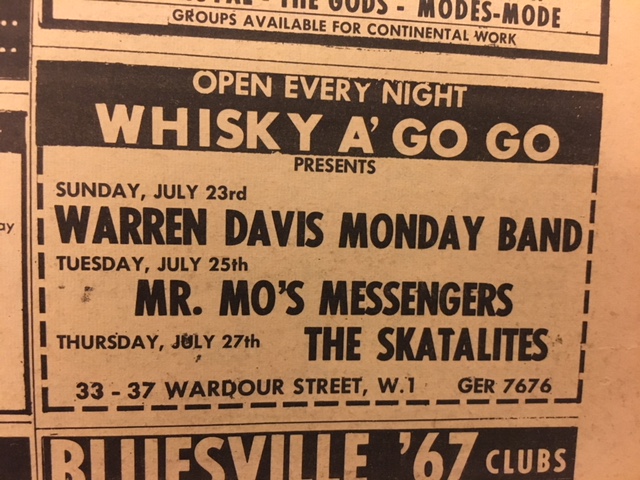
23 July 1967 – Whisky A Go Go, Wardour Street, Soho, central London (late nighter)
29 July 1967 – Leeds International Club, Leeds, West Yorkshire
30 July 1967 – Upper Cut, Forest Gate, east London
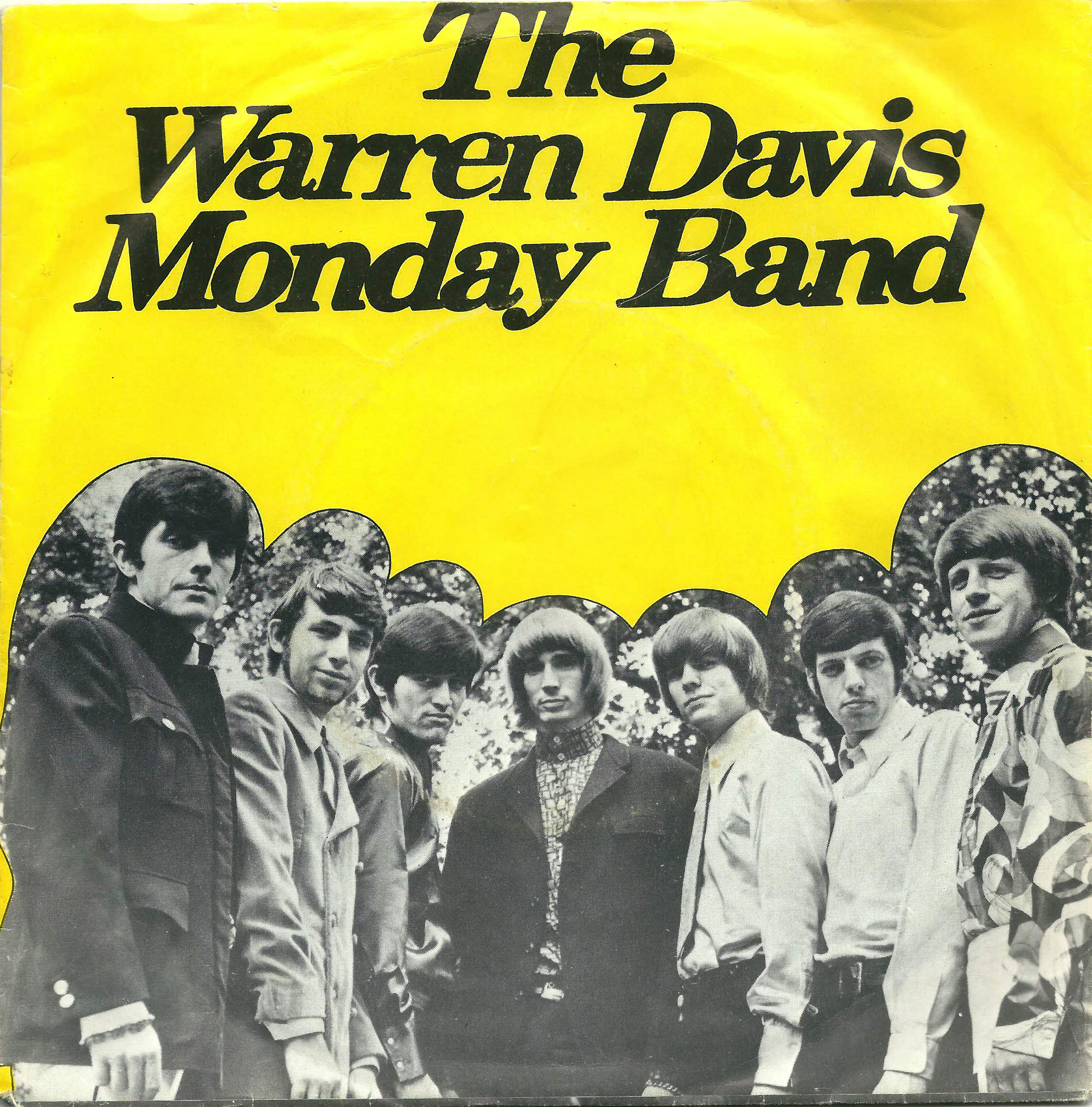
2 August 1967 – The current formation cuts two tracks at Regent Sound studios with Jeff Collins producing. The recordings are featured on their second single – a cover of the Raleigh/Linden co-write (and recorded by Lou Rawls) “Love Is A Hurtin’ Thing” c/w Warren Davis and David Foster’s “Without Fear” (Columbia BD 8270).
4 August 1967 – Roaring ‘20s, Carnaby Street, Soho, central London
6 August 1967 – Upper Cut, Forest Gate, east London with Eric Burdon & The Animals
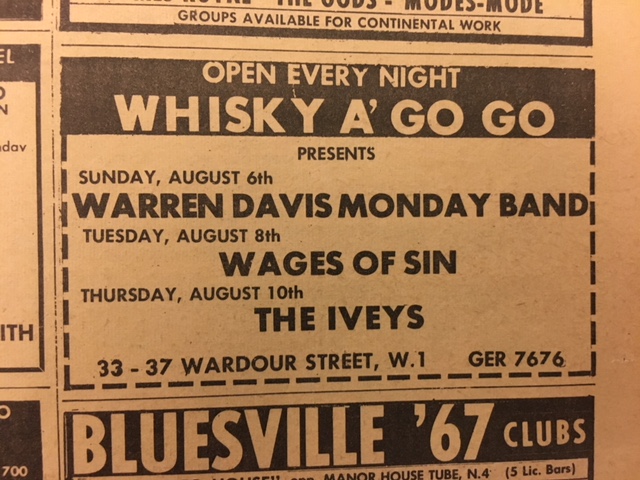
6 August 1967 – Whisky A Go Go, Wardour Street, Soho, central London
Soon after, the band headed to Naples, Italy to play at the NATO base from 9-16 August. The trip was a disaster as the club on the base didn’t know anything about the booking and the group only played a few times so they could afford to return to London.
19 August 1967 – Roaring ‘20s, Carnaby Street, Soho, central London
26 August 1967 – Nautilus Club, Lowestoft, Suffolk
27 August 1967 – Cat-Balou, Grantham, Lincolnshire (Grantham Journal) This isn’t in Del Paramor’s gig list so was probably cancelled
28 August 1967 – Roaring ‘20s, Carnaby Street, Soho, central London
28 August 1967 – Whisky A Go Go, Wardour Street, central London
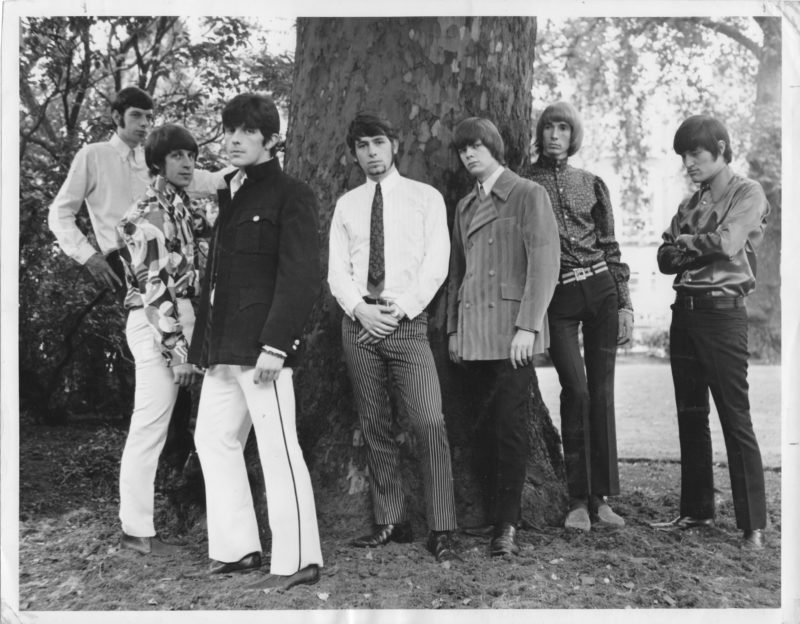
Following the double-nighter in Soho, David Foster, Mick Patel and Bruce Usherwood all departed. Usherwood subsequently joined Patrick Dane & The Front Line Band. Foster returned to Canada where he became a successful solo artist and producer.
The band regrouped, adding two former members of The Overlanders, lead guitarist Paul Brett and bass player Paul Petts. They also brought in keyboard player Keith Beck (real name: Burberry).
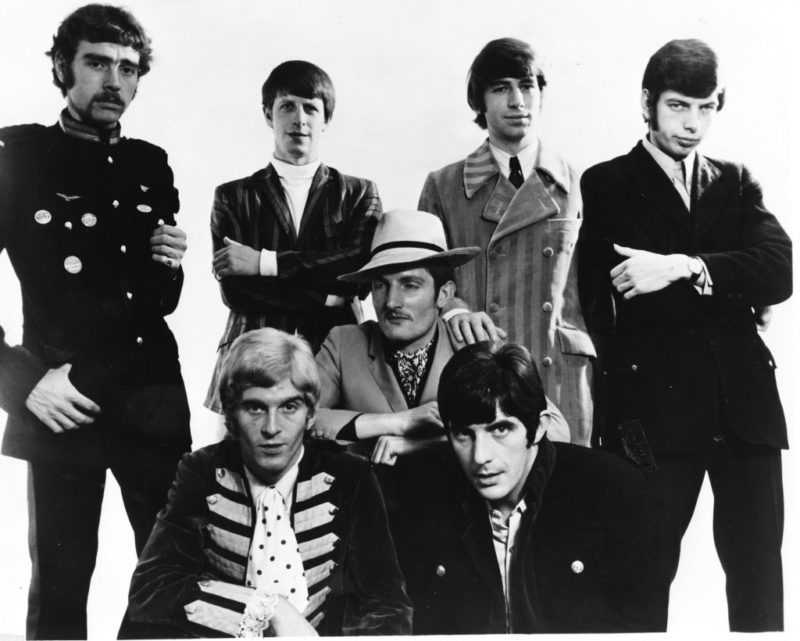
The line-up now comprised:
Warren Davis – lead vocals
Paul Brett – lead guitar/vocals
Keith Beck – Hammond organ
Martin Grice – tenor saxophone
Del Paramor – tenor saxophone
Paul Petts – bass
Peter Mole – drums
8 September 1967 – Harrow Inn, Woolwich, southeast London
9 September 1967 – Starlite Ballroom, Greenford, northwest London
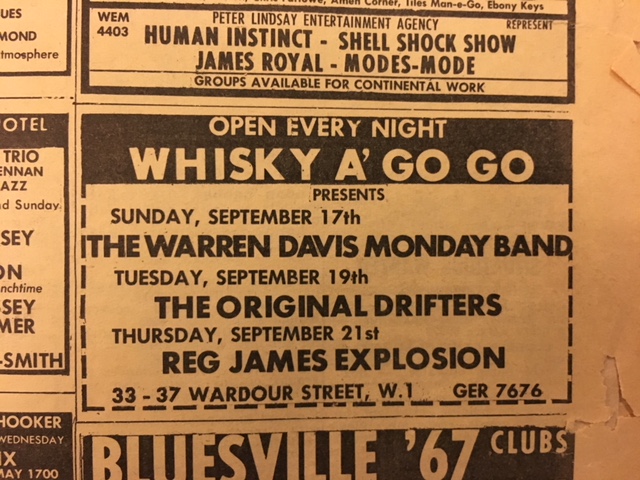
17 September 1967 – Whisky A Go Go, Wardour Street Soho, central London
22 September 1967 – Cooks Ferry Inn, Edmonton, north London
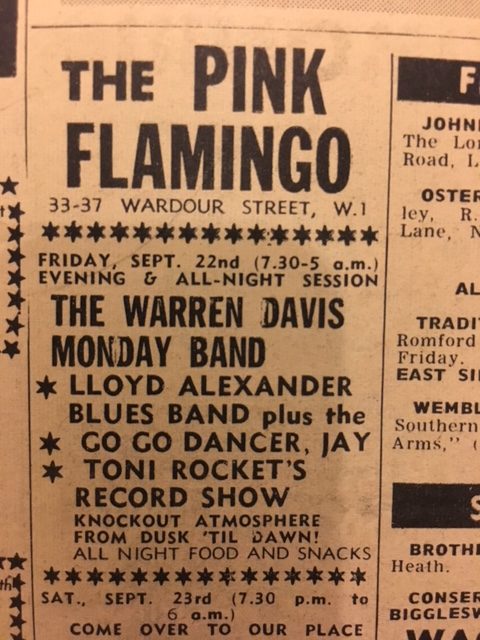
22 September 1967 – Pink Flamingo, Soho, central London with Lloyd Alexander’s Blues Band
23 September 1967 – Luton Boys Club, Luton, Bedfordshire
29 September 1967 – Elm Hotel, Leigh on Sea, Essex
30 September 1967 – Ritz, Bournemouth, Dorset
1 October 1967 – Lyme Regis, Dorset (possibly Marine Theatre)
4 October 1967 – Flamingo, Soho, central London

6 October 1967 – Cesar’s Club, Bedford, Bedfordshire with The Locomotion
7 October 1967 – Croydon Tech, Croydon, south London
10 October 1967 – Staircase, Soho, central London (opening night of club with Cat Stevens as guest of honour, who wasn’t performing)
13 October 1967 – Beachcomber (Dunstable, Bedfordshire?)

14 October 1967 – Royal Lido, Prestatyn, Wales with The Raynes (Rhyl & Prestayn Gazette)
16 October 1967 – Birdcage, Harlow, Essex

20 October 1967 – Silver Blades, Streatham, southwest London
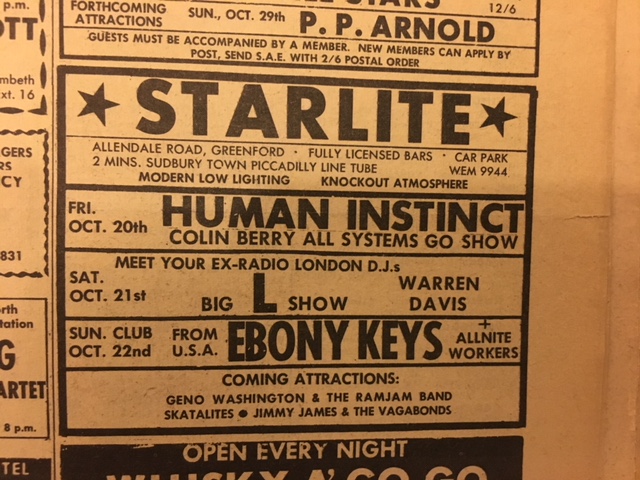
21 October 1967 – Starlite Ballroom, Greenford, northwest London
21 October 1967 – Roaring ‘20s, Carnaby Street, Soho, central London
28 October 1967 – Assembly Rooms, Oxford Town Hall, Oxford, Oxfordshire
31 October 1967 – Beachcomber, Dunstable, Bedfordshire
4 November 1967 – On this day, the Daily Sketch “Monkees” article appeared, only to be denied later in Variety
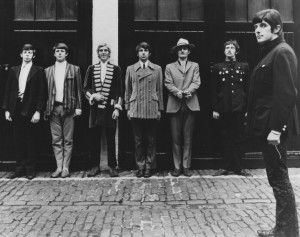
4 November 1967 – Reading University, Reading, Berkshire
8 November 1967 – The band records Paul Petts’ “What’s It Like Down There?” at Tony Pike Music Ltd studios in Putney.
9 November 1967 – The musicians record Paul Brett and Paul Petts’ “Queen Victoria” at Tony Pike Music Ltd studios in Putney. Both tracks are shelved.
10 November 1967 – Staircase, Soho, central London

11 November 1967 – Corby Civic Centre, Corby, Northamptonshire with The Blue Magnum
14 November 1967 – Dollar Disco, Slough, Berkshire

15 November 1967 – Industrial Club, Norwich, Norfolk (Eastern Evening News) Missing from Del Paramor’s gigs so may have been cancelled
16 November 1967 – Marquee, Wardour Street, central London (with either The Syn or Love Affair)

17 November 1967 – Queen’s Hall, Leeds, West Yorkshire with Pink Floyd, John Mayall’s Bluesbreakers, Ivan’s Jaguars, The JB’s, The Peighton Checks, Roger Bloom’s Hammer, The Roll Movement, The Screen and The Syndicate (Yorkshire Evening Post)
18 November 1967 – St Paul’s College, Shaftesbury Hall, Cheltenham, Gloucestershire
22 November 1967 – Dundee University, Dundee, Scotland

23 November 1967 – String O’ Beads, Bradford, West Yorkshire (Yorkshire Evening Post)
25 November 1967 – Castle Ballroom, Ryde, Isle of Wight
28 November 1967 – Racing Drivers Ball, Savoy Hotel, Strand, London
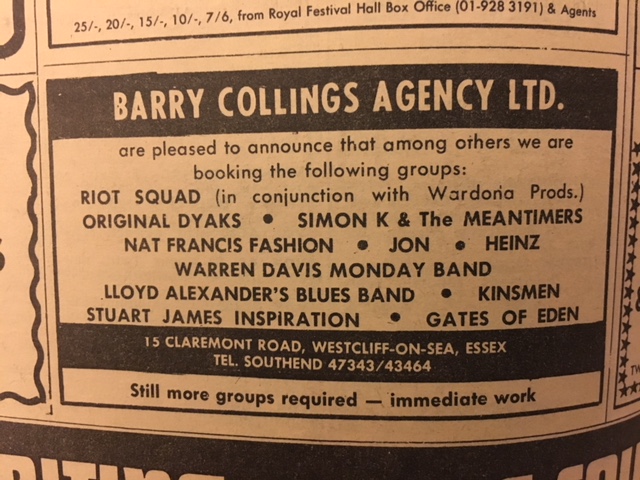
1 December 1967 – North West Polytechnic, Royal Hotel, Woburn Place, London with Denny Laine’s Electric String Band and Fleetwood Mac
2 December 1967 – Witham (possibly Public Hall), Essex
3-4 December 1967 – String O’Beads, Bradford, West Yorkshire
5 December 1967 – Bradford University, Bradford, West Yorkshire with The Crazy World of Arthur Brown
8 December 1967 – Shooters Hill Grammar School, Shooters Hill, SE10, near Greenwich, London
9 December 1967 – Witchdoctor, Catford, southeast London

10 December 1967 – RAF Witton, Kidderminster, Worcestershire (held at Frank Freeman’s)
15 December 1967 – Winter Gardens, Penzance, Cornwall

16 December 1967 – Blue Lagoon, Newquay, Cornwall with The Future Impression (billed as Dave Warren Monday Band)
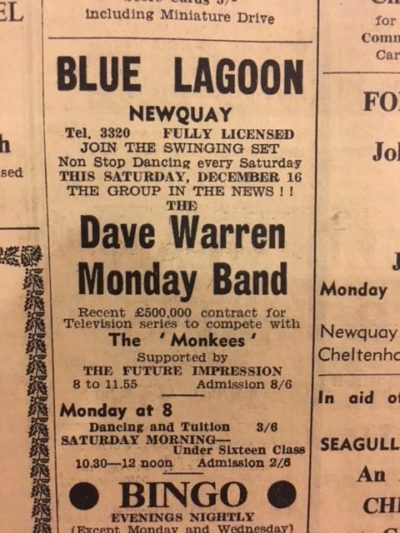
18-20 December 1967 – Horseshoe Club, Ashton-under-Lyne, Greater Manchester
22 December 1967 – Jason’s Club, Barnstaple, Devon
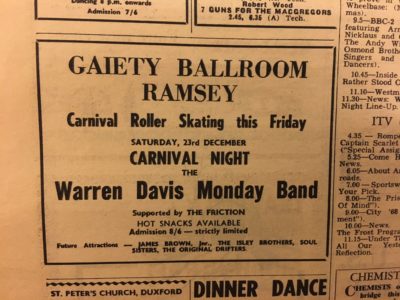
23 December 1967 – Gaiety Ballroom, Ramsey, Cambridgeshire with Friction
24 December 1967 – Corn Exchange, Maidstone, Kent
29 December 1967 – Pantiles, Bagshot, Surrey
30 December 1967 – Luton Boys Club, Luton, Bedfordshire
31 December 1967 – Blaises, Kensington, west London
Paul Brett left early in the new year. He joined Tintern Abbey and later led his own group, Paul Brett’s Sage after playing with Elmer Gantry’s Velvet Opera, Velvet Opera and Fire. Tony Ollard joined after working with The Creation (he’d replaced Eddie Phillips).
The new line up now comprised:
Warren Davis – lead vocals
Tony Ollard – lead guitar
Keith Beck – Hammond organ
Martin Grice – tenor saxophone
Del Paramor – tenor saxophone
Paul Petts – bass
Peter Mole – drums
4 January 1968 – Warwick Hall, Kimpton Road, southeast London
5 January 1968 – El Grotto, Ilford, east London
6 January 1968 – Shades, Sheffield, South Yorkshire
6 January 1968 – String of Beads, Bradford, West Yorkshire
7-8 January 1968 – Hatchetts, Piccadilly, central London
9 January 1968 – Carousel Club, Farnborough, Hampshire
9 January 1968 – Sybillas, Swallow Street, central London
11 January 1968 – Whisky A Go Go, Wardour Street, Soho, central London
13 January 1968 – College of Technology, Brighton, West Sussex
16 January 1968 – The new line up returns to Tony Pike’s Putney studio and record another Paul Petts song, “Thinkin’ About Tomorrow” and Warren Davis’ “Frances”. Both tracks are shelved.
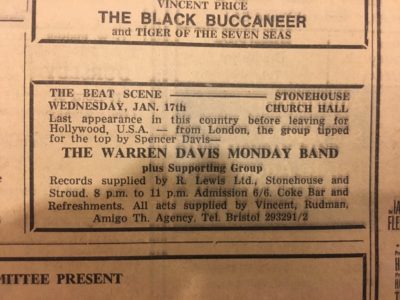
17 January 1968 – Church Hall, Stonehouse, Gloucestershire

18 January 1968 – Liberal Hall, Yeovil, Somerset (Western Gazette)

19 January 1968 – Bristol, Avon (gig was cancelled)

20 January 1968 – YMCA, Gloucester, Gloucestershire with Here, There & Everywhere
25 January 1968 – Audition for BBC, central London
27 January 1968 – White Tiles, Swindon, Wiltshire

30 January 1968 – The Blue, Rotherhithe, southeast London
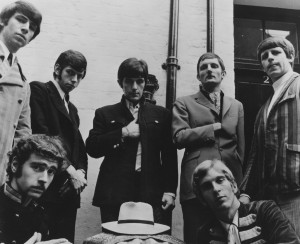
1 February 1968 – Whisky A Go Go, Wardour Street, Soho, central London
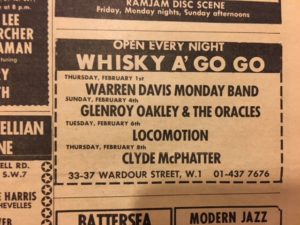
3 February 1968 – RAF Waddington, Lincoln, Lincolnshire

4-5 February 1968 – Leofric Hotel, Coventry, West Midlands (also gig at Mercer’s Arms, Coventry on 5 February)
9 February 1968 – Big C, Farnborough, Hampshire (Aldershot News) Missing from Del Paramor’s gig list so may have been cancelled

10 February 1968 – Hastings Pier, Hastings, East Sussex with The Block

13-28 February 1968 – Hotel Pino, Turin, Italy
1-17 March 1968 – Blow Up Club, Munich, West Germany
With the German dates completed, Martin Grice and Keith Beck returned to Turin and joined The Patrick Sansom Set.
Back in the UK in March 1968, the remaining members rehearsed new baritone sax player Roger Davis and debuted at Klooks Kleek in West Hampstead on 21 March 1968.
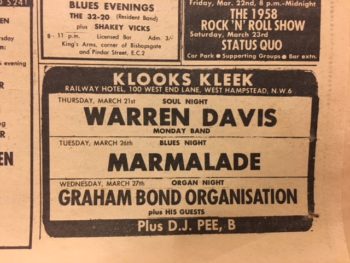
18 March 1968 – Rhodes Centre, Bishop’s Stortford, Herts (billed as Warren Davis The Monday Band) This gig was billed but did not happen
21 March 1968 – Klooks Kleek, West Hampstead, north London (new line-up’s debut)

28 March 1968 – Liberal Hall, Yeovil, Somerset with Emotion (Western Gazette) Del Paramor says that this gig was cancelled
However, there was a split in the band’s ranks at this point with Warren Davis, Del Paramor and Roger Davis linking up with the group Still Life to form a new version of The Warren Davis Monday Band. Tony Ollard, Paul Petts and Pete Mole split to work on other projects. Ollard (see comments) moved to Italy.
Davis, Paramor and Davis had seen Still Life at the Marquee on 25 March 1968 and were impressed.
The new formation comprised:
Warren Davis – lead vocals
Stuart Cowell – guitar/lead vocals
Tom Tierney – guitar
Con Byrne – bass
Ron Reynolds – Hammond organ
Del Paramor – tenor saxophone
Roger Davis – baritone saxophone
Jim Toomey – drums
The new line-up recorded the track “No 9 Putney Bus” for what they hoped would be a TV series.
30 March 1968 – Cheltenham, Gloucestershire
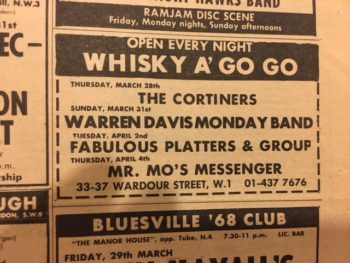
31 March 1968 – Whisky A Go Go, Wardour Street, Soho, central London
3 April 1968 – Blaises, Kensington, west London
5 April 1968 – Queen’s Hall, Barnstaple, Devon
6 April 1968 – Tardebigge, Redditch, Worcestershire (venue unknown)

19 April 1968 – El Grotto, Ilford, east London (Del Paramor says David Essex turned up to see him at the gig which was a disaster)
20 April 1968 – Hastings Pier, Hastings, East Sussex (billed as Still Life)
24 April 1968 – Blaises, Kensington, west London
26 April-2 May 1968 – Rose Club, Hannover, West Germany
4 May 1968 – Tofts, Folkestone, Kent
7 May 1968 – Concorde, Southampton, Hampshire (Del Paramor and Roger Davis told they were sacked)
9 May 1968 – Quay Club, Exeter, Devon
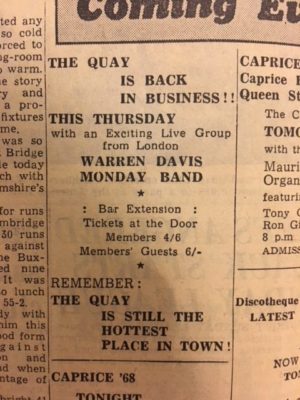
10 May 1968 – Scottish Club Discotheque, Torquay, Devon (Herald Express)
11 May 1968 – Cirencester, Gloucestershire (possibly Stax Club)
14 May 1968 – Sybillas, Swallow Street, central London
15 May 1968 – Hampstead Country Club, north London
Del Paramor and Roger Davis left after this gig. Paramor joined Mr Mo’s Messengers, who morphed into Sonority, where he worked with Peter Mole.
20 May 1968 – Rhodes Centre, Bishop’s Stortford, Herts with Fish-Hook (billed as Warren Davis Band)
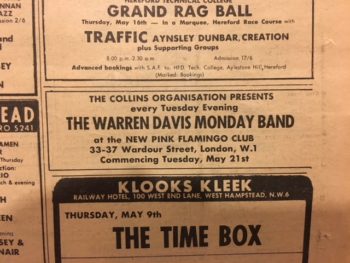
21 May 1968 – New Pink Flamingo, Wardour Street, Soho, central London
23 May 1968 – Whisky A Go Go, Wardour Street, Soho, central London

26 May 1968 – El Grotto, Ilford, east London (Redbridge & Ilford Recorder)
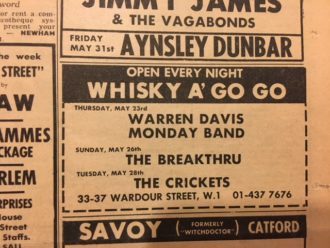
28 May 1968 – New Pink Flamingo, Wardour Street, Soho, central London
29 May 1968 – Hampstead Country Club, north London

1 June 1968 – Starlight Room, Boston Gliderdrome, Boston, Lincolnshire with C G Morris and The Reactions
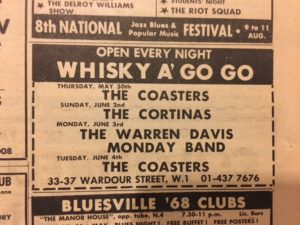
3 June 1968 – Whisky A Go, Wardour Street, Soho, central London
Guitarist Tom Tierney left around now. Warren Davis and Con Byrne wrote “The Painter”, which Elmer Gantry’s Velvet Opera record.
Two other tracks credited to Byrne-Davis: “Fire Fly” and “Deed I Do” were cut as acetates.
At some point, possibly with this final formation, the band cut two tracks at IBC Sound Recording Studios in Portland Place: “Nothing Is Sweeter Than Lovin’ You” and “Muddy Water”.

15 June 1968 – Hastings Pier, Hastings, East Sussex
29-30 June 1968 – Blue Lagoon, Newquay, Cornwall with The Vigilantes (Saturday) and The Provokers (Sunday)

By mid-July 1968 the band’s line-up comprised:
Warren Davis – lead vocals
Stuart Cowell – lead guitar/vocals
Ron Reynolds – Hammond organ
Con Byrne – bass
Jim Toomey – drums
Judging by a gig in Switzerland in mid-September (see comments), the band may have played some European dates around this time.

19 September 1968 – Klooks Kleek, West Hampstead, north London
The musicians, however, went their separate ways by late September 1968. Cowell and Toomey would form a new band with Jerome Arnold from Paul Butterfield’s Blues Band and later put together Titus Groan.
Warren Davis (see comments) audition for The Foundations but was not successful. In 1971 he co-wrote both sides of a single with Byrne for the band Mighty Dodos, which was released on Spark.
Huge thanks to Del Paramor for the gigs listings from July 1967-May 1968. Thanks to Del, Bruce Usherwood, Paul Brett and Stuart Cowell for details. Melody Maker also provided gigs for the Upper Cut, Forest Gate, London. I also used a number of regional newspapers for gigs. I will be writing a more detailed article on the band and would welcome hearing from other former members.
Copyright © Nick Warburton. All Rights Reserved. No part of this article may be reproduced or transmitted in any from or by any means, without prior permission from the author.

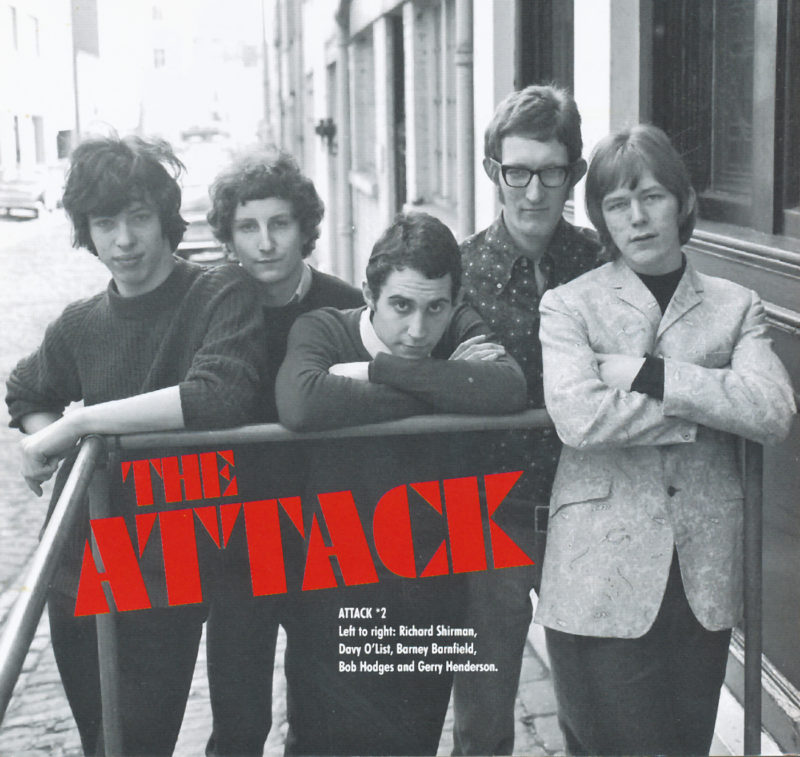 THE ATTACK:
THE ATTACK:
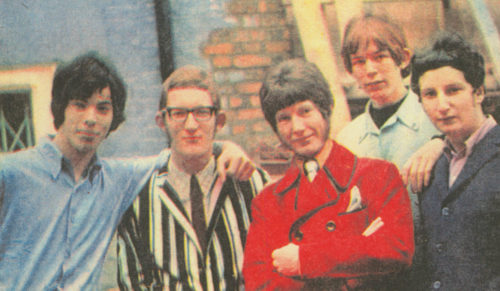


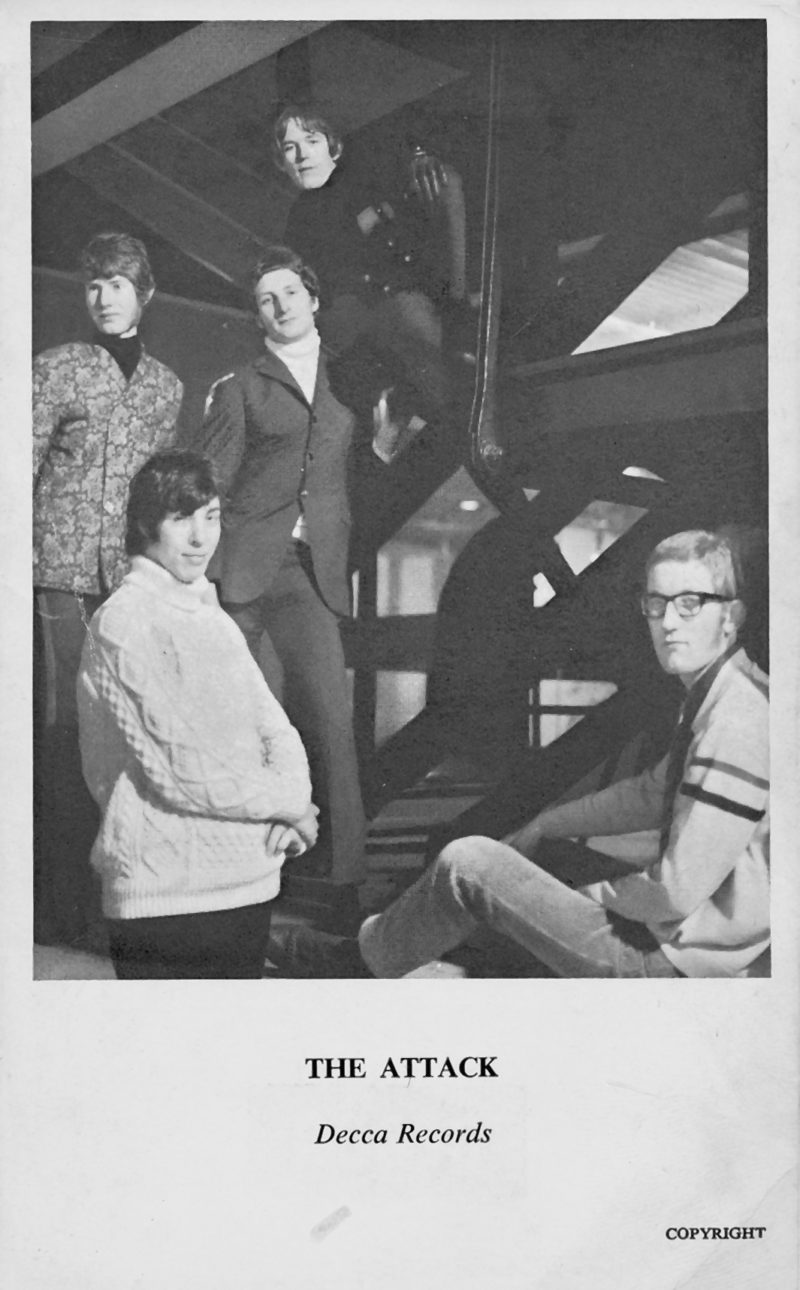



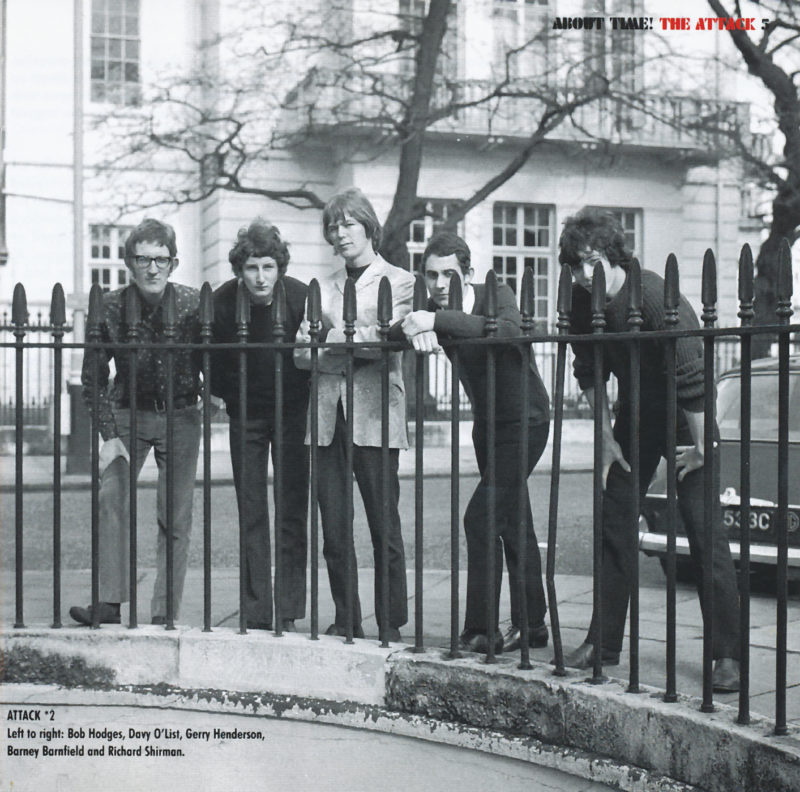


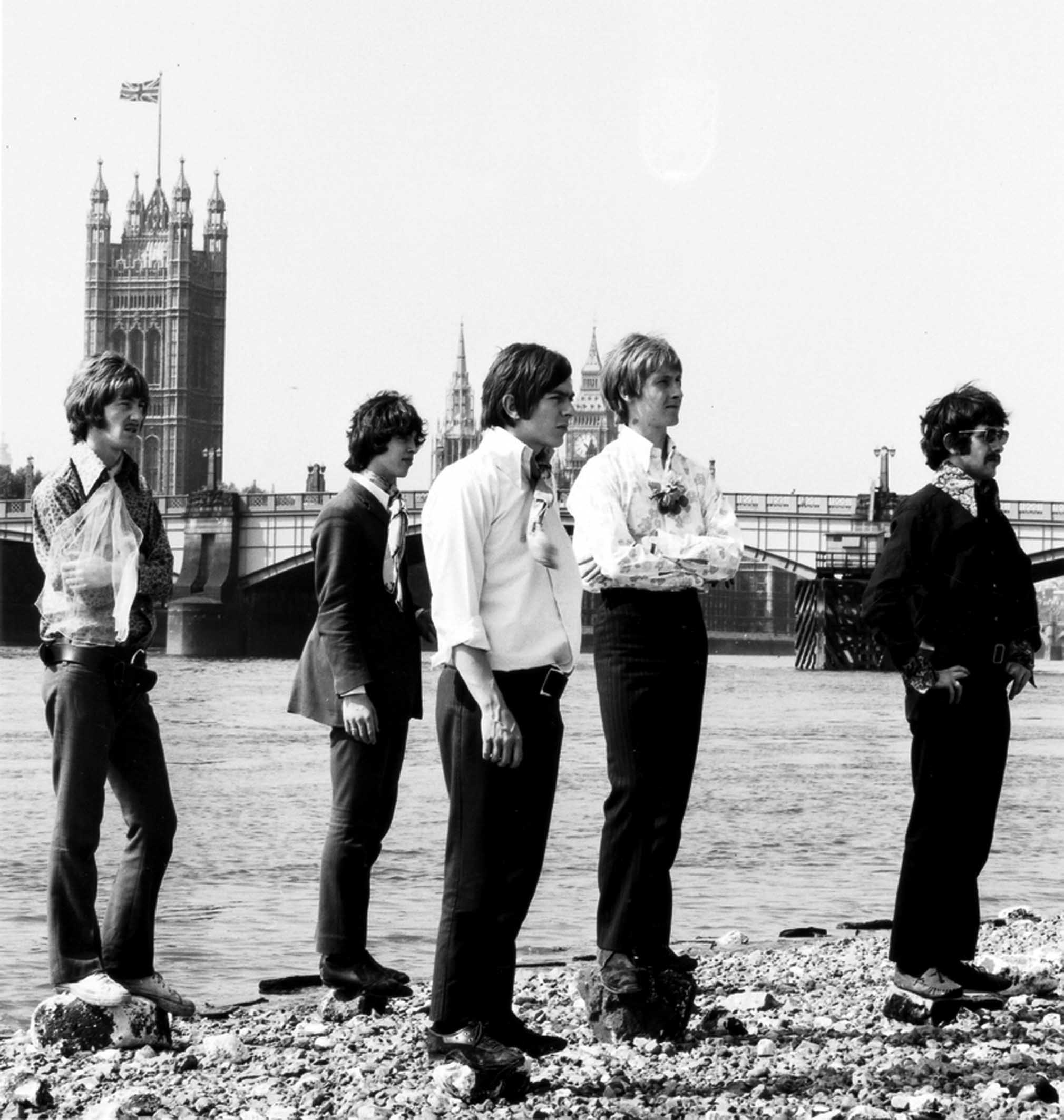


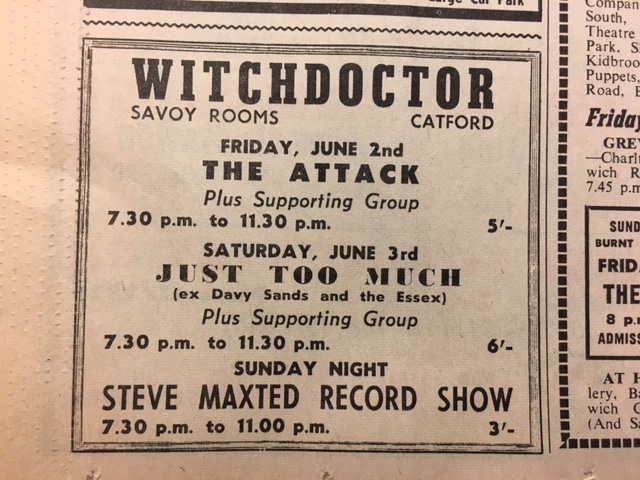




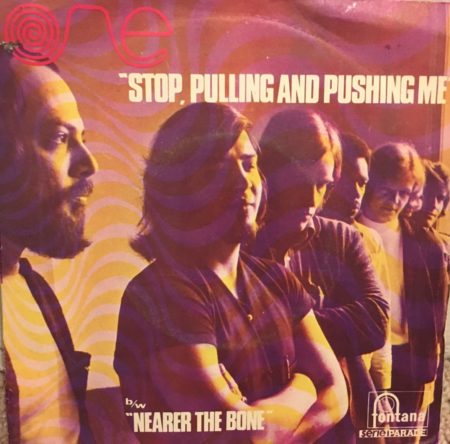
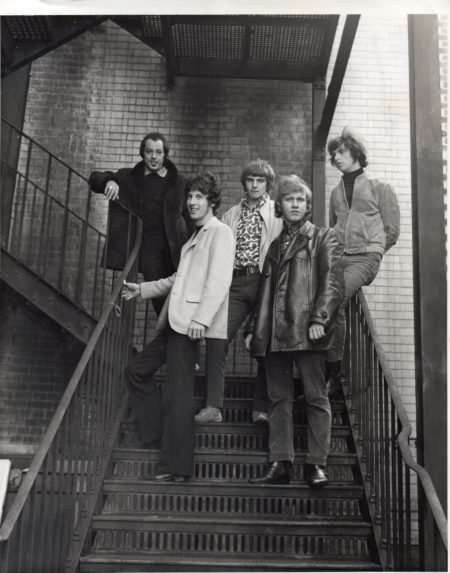
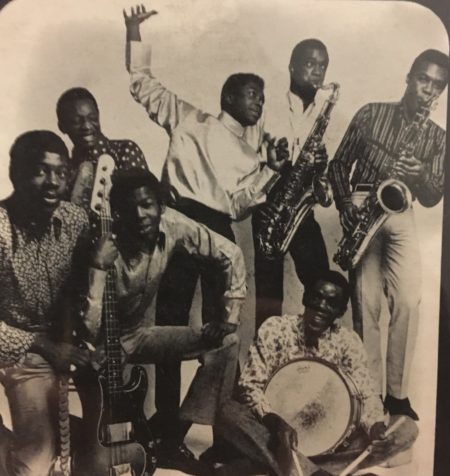
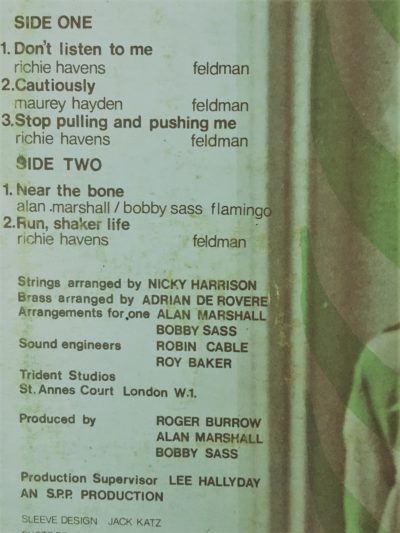 Production was split between the band’s manager Roger Burrow and Alan Marshall and Bobby Sass, working with sound engineers Robin Cable and Roy Baker. Production supervision meanwhile was handled by Lee Hallyday, who’d recently recorded his brother Johnny’s self-titled LP in France. According to several band members, the sessions at Trident’s studios also featured Alan Marshall’s former band mate from The Loose Ends and Happy Magazine, Peter Kirtley, who provided lead guitar on several cuts.
Production was split between the band’s manager Roger Burrow and Alan Marshall and Bobby Sass, working with sound engineers Robin Cable and Roy Baker. Production supervision meanwhile was handled by Lee Hallyday, who’d recently recorded his brother Johnny’s self-titled LP in France. According to several band members, the sessions at Trident’s studios also featured Alan Marshall’s former band mate from The Loose Ends and Happy Magazine, Peter Kirtley, who provided lead guitar on several cuts.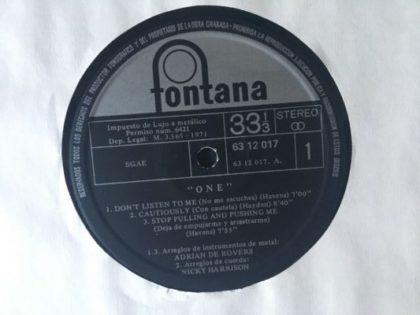 That may well be, but One’s storming cover of Havens’ “Don’t Listen To Me”, which opens the LP and third track, “Stop Pulling and Pushing Me” are inspired, extended workouts full of inventive playing and powerful instrumental passages. The musicians also do justice to “Cautiously”, an atmospheric reading of the ballad written by Maurey Hayden, singer, stand-up comedian and wife of Lenny Bruce. Alan Marshall and Bobby Sass’s “Near The Bone”, the band’s lone contribution to the song-writing stakes is also noteworthy.
That may well be, but One’s storming cover of Havens’ “Don’t Listen To Me”, which opens the LP and third track, “Stop Pulling and Pushing Me” are inspired, extended workouts full of inventive playing and powerful instrumental passages. The musicians also do justice to “Cautiously”, an atmospheric reading of the ballad written by Maurey Hayden, singer, stand-up comedian and wife of Lenny Bruce. Alan Marshall and Bobby Sass’s “Near The Bone”, the band’s lone contribution to the song-writing stakes is also noteworthy.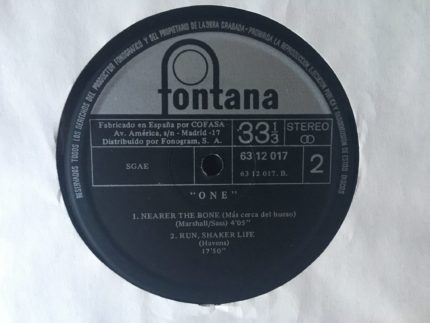 During March-April 1970, the musicians got to meet Stephen Stills, who was in London to record sessions for his first solo LP. It’s not clear who in the band made the initial contact. Marshall says that he used to leave the flat door open and musicians used to wander in. One strong possibility is Roger Burrow, who of course was a friend of Graham Nash’s. Alan Marshall, however, is pretty certain that it was Bobby Sass who ran into Stills.
During March-April 1970, the musicians got to meet Stephen Stills, who was in London to record sessions for his first solo LP. It’s not clear who in the band made the initial contact. Marshall says that he used to leave the flat door open and musicians used to wander in. One strong possibility is Roger Burrow, who of course was a friend of Graham Nash’s. Alan Marshall, however, is pretty certain that it was Bobby Sass who ran into Stills.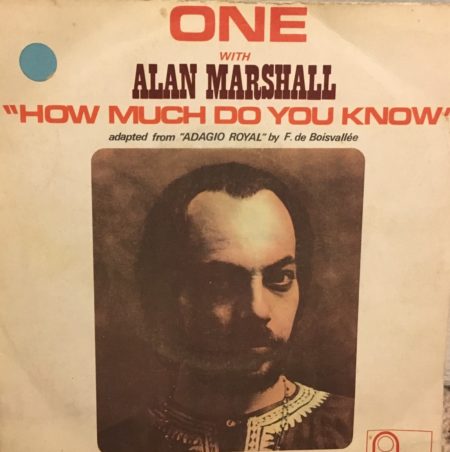 Interestingly, while One’s revolving door of personnel changes continued at pace, Fontana issued a French-only ‘45, ‘How Much Do You Know” (adapted from Adagio Royal by F de Boivallee), which was credited solely to Alan Marshall backed by One’s ‘Don’t Listen To Me”.
Interestingly, while One’s revolving door of personnel changes continued at pace, Fontana issued a French-only ‘45, ‘How Much Do You Know” (adapted from Adagio Royal by F de Boivallee), which was credited solely to Alan Marshall backed by One’s ‘Don’t Listen To Me”.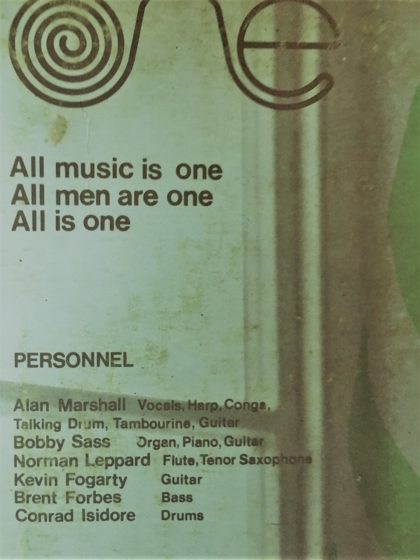 As for One, the group remains something of an obscurity. While the LP has been issued on CD by two different labels, neither appear to be official releases. Given the collectability of the record and the fact that a mint copy will probably fetch you close to £100, perhaps it’s time that the band was given a proper re-issue treatment, complete with detailed liner notes.
As for One, the group remains something of an obscurity. While the LP has been issued on CD by two different labels, neither appear to be official releases. Given the collectability of the record and the fact that a mint copy will probably fetch you close to £100, perhaps it’s time that the band was given a proper re-issue treatment, complete with detailed liner notes.